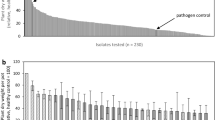Abstract
In 1983, seed dressing of peas with fosetyl-Al (Aliette) compared favourably with all other treatments on a field heavily contaminated with foot and root rot pathogens. Experiments carried out in 1983 and 1984 could not establish the reason for this phenomenon. Artificial inoculation with the most frequently isolated pathogens (Fusarium oxysporum, Phoma medicaginis var.pinodella, Pythium ultimum andFusarium solani f.sp.pisi) of sterilized soil before planting treated seeds did not reproduce the field observations, but glasshouse experiments using soil from the experimental field did. Glasshouse experiments in 1989, afterAphanomyces euteiches had been identified as a frequently occurring pea pathogen in the Netherlands, confirmed the favourable effect of fosetyl-Al as a seed treatment whenA. euteiches was in the pathogen flora.
Samenvatting
In 1983 bleek op een zwaar met voetrotpathogenen besmet veld zaaizaadbehandeling van erwten met fosetyl-Al (Aliette) gunstig af te steken bij alle andere behandelingen. De oorzaak kon toen niet worden gevonden. Kunstmatige besmetting van gesterilisserde grond vóór het planten van behandelde zaden met de meest geïsoleerde pathogenen (Fusarium oxysporum, Phoma medicaginis var.pinodella, Pythium ultimum enFusarium solani f.sp.pisi) gaf resultaten die niet overeenstemden met die van het proefveld, maar kasproeven met grond van het proefveld deden dat wel. Nadat was aangetoond dat het erwtepathogeenAphanomyces euteiches in Nederland veel voorkomt, bevestigden nieuwe kasproeven in 1989 het gunstige effect van fosetyl-Al als zaaizaadbehandeling wanneerA. euteiches deel uitmaakt van de pathogene bodemflora.
Similar content being viewed by others
References
Afek, U. & Sztejnberg, A., 1989. Effects of fosetyl-Al and phosphorous acid on scoparone, a phytoalexin associated with resistance ofCitrus toPhytophthora citrophthora. Phytopathology 79: 736–739.
Allen, R.N., Letham, D.B., Akehurst, A.A. & Say, M.M., 1987.Aphanomyces root rot of bean at Valla, New South Wales. Australasian Plant Pathology 16: 82–84.
Anonymous, 1989. Teelt van droge erwten. Teelthandleiding nr. 28. Consulentschap in algemene dienst en Proefstation voor de Akkerbouw en de Groenteteelt in de Vollegrond, Lelystad, 80 pp.
Basu, P.K., Brown, N.J., Crête, R., Gourly, C.O., Johnston, H.W., Pepin, H.S. & Seaman, W.L., 1976. Yield loss conversion factors forFusarium root rot of pea. Canadian Plant Disease Survey 56: 25–32.
Bompeix, G., 1982. Phoséthyl-Al, une nouvelle voie dans la lutte contre les maladies des plantes. Phytoma, Défense des cultures 342: 14–15.
Dustan, R.H. & Grant, B.R., 1990. The presence of phosphonate-sensitive macromolecules on the surfaces ofPhytophthora spp. Abstracts 4th. International Mycological Congress. Regensburg, 28th aug.–3rd sept. 1990: 181.
Guest, D.I., 1984a. Modification of defence responses in tobacco andCapsicum following treatment with fosetyl-Al [Aluminium tris(o-ethyl phosphonate)]. Physiological Plant Pathology 25: 125–134.
Guest, D.I., 1984b. The influence of cultural factors on the direct antifungal activities of Fosetyl-Al, Propamocarb, Metalaxyl, SN 75196 and Dowco 444. Phytopathologische Zeitschrift 111: 155–164.
Kraft, J.M., 1982. Field and greenhouse studies on pea seed treatments. Plant Disease 66: 798–800.
Kraft, J.M. & Papavizas, G.C., 1983. Use of host resistance,Trichoderma, and fungicides to control soilborne diseases and increase seed yields of peas. Plant Disease 67: 1234–1237.
Oyarzun, P. & Van Loon, J., 1989.Aphanomyces euteiches as a component of the complex of foot and root pathogens of peas in Dutch soils. Netherlands Journal of Plant Pathology 95: 259–264.
Salter, W.J. & Smith, J.M., 1986. Peas — Control of establishment pests and diseases using metalaxyl based seed coating. Proceedings 1986 British Crop Protection Conference, Pests & Diseases, Vol. 3: 1093–1100.
Smillie, R.H., Dunstan, R.H., Grant, B.R., Griffith, J.M., Iser, J. & Niere, J.O., 1990. The mode of action of the antifungal agent phosphite. EPPO Bulletin 20: 185–192.
Trawally, B.B., Noonan, M.A.J. & Close, R.C., 1984. The effects of seed treatment on plant establishment, downy mildew and yield of peas. In: Proceedings 37th New Zealand weed and pest control Conference, Hastings: 163–166.
Tsvetkova, N.A. & Guseva, T.A., 1980. The effect ofAphanomyces euteiches Drechs., pathogen of root rot of pea, and Tachigaren on the chemical composition of pea plants. Byuleten' Vsesoyuznogo Nauchno-Issledovatel'skogo Instituta Zashchity Rastenii 47: 45–49. (From Review of Plant Pathology 64 (1985), 1)
Tu, J.C., 1988. Development and evaluation of new seed treatment formulations for pea root rots. Mededelingen van de Faculteit der Landbouwwetenschappen van de Rijksuniversiteit Gent, 40, I: 389–393.
Author information
Authors and Affiliations
Rights and permissions
About this article
Cite this article
Oyarzun, P., Gerlagh, M., Hoogland, A.E. et al. Seed treatment of peas with fosetyl-Al against Aphanomyces euteiches. Netherlands Journal of Plant Pathology 96, 301–311 (1990). https://doi.org/10.1007/BF02000171
Accepted:
Issue Date:
DOI: https://doi.org/10.1007/BF02000171




